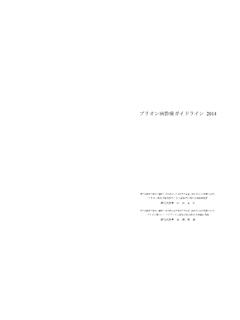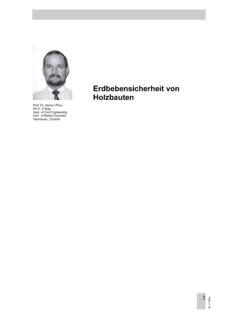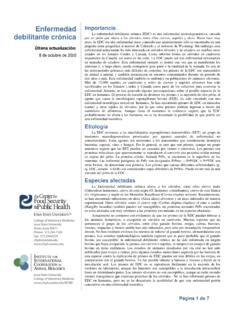Transcription of Bovine spongiform encephalopathy (BSE)
1 1 What is BSE?BSE is a progressive, fatal disease of the nervous system of cattle. The disease has a long incubation period of four to fi ve years and there is currently no treatment or vaccine for the is one of a group of diseases known as transmissible spongiform encephalopathy (TSE). Other TSEs include scrapie in sheep, chronic wasting disease (CWD) in deer and elk, and Creutzfeldt-Jakob disease in humans. A neurological disease in cats has been linked to , like other TSEs, is characterized by the presence of an abnormal infectious protein called a prion in nervous tissue. The subsequent spongy degeneration of the brain results in severe and fatal neurological signs and symptoms. BSE is a disease listed in the World Organisation for Animal Health (OIE) Terrestrial Animal Health Code and must be reported to the OIE (OIE Terrestrial Animal Health Code). BSE is a disease for which the OIE established offi cial recognition of the sanitary status countries and zones.
2 Bovine spongiform encephalopathy (BSE)General Disease Information Sheets2 Where is the disease found?BSE was fi rst diagnosed in cattle in the United Kingdom (UK) in 1986. The disease has occurred in Europe, Asia, the Middle East (Israel) and North is the disease transmitted and spread?Scientists believe that the spread of this disease in cattle is caused by feeding rendered material from infected cattle or sheep back to other cattle. The prion is resistant to commercial inactivation procedures such as heat, which means that it may not be completely destroyed in the rendering process. The incidence of BSE is much greater for dairy than beef, since generally, dairy herds are fed concentrate rations that contain meat-and-bone is the public health risk associated with this disease? There are indications that variant Creutzfeldt-Jakob Disease (vCJD) in humans could be caused by the consumption of beef products contaminated by infected nervous tissue or medical devices manufactured from infected animal tissues.
3 The risk linked with consumption is addressed by the requirement for routine removal of all visible nervous and lymphatic tissue (Specifi ed Risk Materials (SRMs)) from carcasses during the processing of cattle as well as the removal of any suspect animals from the human food chain. Appropriate handling of nervous and lymphatic tissue tissues from BSE-suspect animals in abattoirs and laboratories is indicated to avoid accidental exposure (ocular or oronasal).Milk and milk products are considered safe. The production of human and veterinary pharmaceutical products, medical devices or cosmetics should adhere to strict requirements and ideally avoid the use of Bovine materials or materials from other animal species in which TSEs naturally Disease Information Sheets3 Bovine spongiform encephalopathy (BSE)What are the clinical signs of the disease?Since the average time between an animal s infection with the prion and the onset of clinical signs normally ranges from four to fi ve years, clinical signs of BSE are found in adult animals.
4 Symptoms may last for a period of two to six months before the animal with BSE may demonstrate some of the following symptoms: nervous or aggressive behaviour; depression; hypersensitive to sound and touch, twitching, tremors; abnormal posture; lack of co-ordination and diffi culty in rising from a lying position; weight loss, or; decreased milk production. How is the disease diagnosed?BSE may be suspected based on clinical signs. Diagnosis can only be confi rmed by microscopic examination of brain tissues (OIE u).What is being done to prevent or control this disease?Prevention and control measures An effective strategy for preventing the introduction or dealing with occurrences of BSE includes: targeted surveillance of occurrences of clinical neurological disease; transparency in reporting fi ndings of BSE; safeguards on importation of live ruminant species and their products, in accordance with the OIE Terrestrial Code; removal of specifi ed risk material (SRM) (brain, spinal column) during slaughter and processing of carcasses; prohibit the inclusion of SRM in animal feeds, thus removing potentially contaminated material from the food chain; Bovine spongiform encephalopathy (BSE) humane destruction of all suspected and susceptible animals exposed to contaminated feed (OIE Terrestrial Animal Health Code); appropriate disposal of carcasses and all animal products (OIE Terrestrial Animal Health Code).
5 Livestock identifi cation to enable effective surveillance and tracing of suspected StatusBSE is a disease for which the OIE established offi cial recognition of the sanitary status countries and zones. The OIE has defi ned a transparent, science-based and impartial procedure for the recognition of BSE disease status of Member Countries and Territories in their entirety or defi ned zones. Categories for BSE disease status include: negligible risk controlled risk undetermined riskDetails on the OIE process for recognition of a country s BSE disease status can be found in the OIE Terrestrial Animal Health Code. 45 More Information?General Disease Information SheetsAsk our experts:List of Reference c-expertise/reference-laboratories/list- of-laboratories/List of Collaborating c-expertise/collaborating-centres/list-o f-centres/ References:1. OIE Terrestrial Animal Health OIE Manual of Diagnostic Tests and Vaccines for Terrestrial OIE Technical Disease Card: OIE web portal on The Center for Food Security and Public Health, Iowa State Merck Veterinary Manual: le=htm/ Atlas of Transboundary Animal Diseases Animales TransfronterizasP.
6 Fernandez, W. White; Ed.: 20116 12, rue de prony 75017 paris france tel. 33 (0)1 44 15 18 88 - fax 33 (0)1 42 67 09 87 photo: / OIE. Inside photos: OIE, OIE, tre Facts BSE was first recognised and defined in the United Kingdom (UK) in November 1986. From 1987 to 2007, the UK has reported more than 180,000 cases of BSE accounting for 97% of all cases reported throughout the world. Canada reported its first case of BSE in May, 2003 in an 8 year old beef cow detected as part of Canada s ongoing BSE surveillance program. The first case of BSE in the United States was reported in December, 2003. The disease was identified in an adult dairy cow (Holstein breed) from the State of Washington. The occurrence of the first case of Bovine spongiform encephalopathy (BSE) in a goat in France was confirmed on 28 January 2005. WHO hosts numerous scientific focussing on the review of possible human public health implications of animal TSEs, with special emphasis on BSE and the evolving state of knowledge on these diseases Since 1987 25 countries in N.
7 America, Europe and Asia have reported cases of BSE to the OIE. The implementation of appropriate control measures resulted in the decline of BSE worldwide from 37,000 cases in 1992 to fewer than 300 in 2006.














